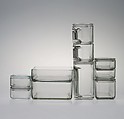"Kubus" Stacking Containers
Manufacturer Vereinigte Lausitzer Glaswerke German
Designer Wilhelm Wagenfeld German
Wilhelm Wagenfeld studied metalwork at the Bauhaus between 1923 and 1925, where he designed a table lamp that became one of the school's most popular products. After leaving the Bauhaus, he went on to design a number of popular consumer products, among the most successful of which was Kubus, the modular glass storage containers he created in 1935. Made of heat-resistant industrial glass, Kubus is designed for maximum flexibility of use and ease of storage. Consisting of seven separate, stackable units of variable sizes and interchangeable lids, the Kubus containers were created for use in the refrigerator and pantry, or on the kitchen table. In this modular system, the containers can be used either together as a unit or individually as needed. Wagenfeld's Kubus system, which was mass produced and widely available, exemplifies the Bauhaus commitment to industrial production of well-designed standardized forms at affordable prices.
Due to rights restrictions, this image cannot be enlarged, viewed at full screen, or downloaded.

